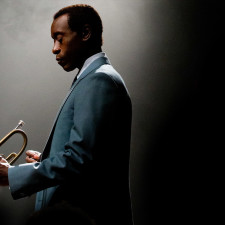With the black arts movement in the United States during the 1960s came politically charged performances by artists such as Max Roach and The Art Ensemble of Chicago, who were attempting to “take back” jazz for blacks from an industry they perceived to be under white control. There is much controversy about the “free jazz” these men played. Melodically and rhythmically it had begun to venture so far outside the traditional parameters of what was traditionally accepted that people began to question whether or not what they were playing really even qualified as music at all, much less jazz music.
Max Roach & Abbey Lincoln – Freedom Now Suite
What these artists attempted to do with their music was radical, but also completely understandable. Jazz had always been about improvisation and innovation, so free jazz proponents saw what they were doing as a logical extension of the genre. Turbulent times during the civil rights movement called for turbulent music, punctuated by hoarse screams (in the “Freedom Now Suite”) and flamboyant costumes (in the Art Ensemble). But while these artists succeeded in blazing new trails in terms of what could be done with music both sonically and socially, it is debatable whether they succeeded in creating what the Art Ensemble termed “great black music.”
James Brown – I Feel Good
While some consider it great, and the artists were black and concerned with Afro-centric history and politics, it never became the music of the black race. In fact, it was artists such as James Brown the “Godfather of Soul”, who was enjoying great popularity during this time among the black community. Although the issues that jazz artists at the time were confronting were important to many black people, the majority failed to see the connection between the progressive politics and the progressive sound of free jazz music.
This divide continues today. Almost everyone, black or white, has heard of Kanye West, but the majority of American youths can probably count the number of contemporary jazz artists they know on one hand. This isn’t to say that the music is irrelevant, or not salvageable, but perhaps we must accept that for a popular audience, it has been subsumed under the umbrella of “rock music,” a term just as indefinable as jazz.
Since Miles Davis pioneered jazz fusion after witnessing his contemporaries Sly and the Family Stone move the crowd in ways that even he no longer felt he could with straight jazz, jazz and rock have borrowed from each other freely. I would submit that jazz still thrives, and that it is commercially viable, although perhaps it exists in a form that would appall the Art Ensemble.
Dirty Projectors – Temecula Sunrise
Artists like Dirty Projectors employ many of the elements of what made bop initially successful. It takes the tried and true pop verse-chorus-verse pop song format and uses traditional rock instrumentation while introducing complex, virtuosic instrumentation, intricate time signatures, and drum beats that weave in and out of the melody instead of simply keeping the beat.
For the most part, the band uses drums, guitar, bass, and keys, instruments that are typically associated with rock music, not jazz, but all of the essential elements are there. Their song “Temecula Sunrise” off of their most recent album Bitte Orca provides a good example.
Radiohead – The National Anthem
Similarly the band Radiohead, one of the biggest “rock” bands in the world, borrows heavily from Charles Mingus tinged hard bop on the songs “The National Anthem” off of their album Kid A (which won the 2000 Grammy for Best Alternative Album) and polyphonic early New Orleans influenced jazz sounds on “Life in a Glasshouse,” off their 2001 album Amnesiac. If Radiohead were not packaged and sold by the industry as a rock band, it would be very difficult to categorize this music as such.
Radiohead – Life In A Glasshouse
However, we must note another important thing these two bands have in common: they both consist exclusively of white men. Is this not just another recurrence of white executives and musicians copping a black musical form in order to appeal to a more mainstream audience and cash in on a black musical innovation? It’s hard to say.
The music industry is different now, with black artists like Jay-Z controlling his own musical empire. But in a lot of ways this certainly looks like a case of white artists “Benny Goodman-ing” jazz music to make it more palatable. It’s certainly not the vision of the Art Ensemble, and so the controversy remains: Is the only way to make jazz music popular to Anglicize it?
STEVEN WAYE
Tags: Abbey Lincoln, Charles Mingus, Dirty Projectors, Free Jazz, Freedom Now Suite, James Brown, Kanye West, Max Roach, Miles Davis, Radiohead, Rock, Sly and the Family Stone, The Art Ensemble of Chicago



 Share On Facebook
Share On Facebook Tweet It
Tweet It







